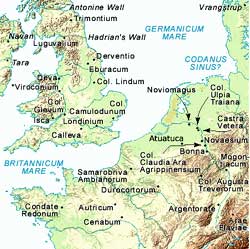
Click on the image for a larger version.
|
Image
details:
Map of northern Gaul and neighbouring areas
in the Roman period
Image ownership:
© Ancient World Mapping project (with modifications) |
One exaction imposed by Rome on many conquered peoples was to contribute
manpower to the Roman army in the form of auxiliary units. The names
of units were taken from their tribes or provinces, revealing the
patterns of recruitment. Names of the units stationed on Hadrian's
Wall reveal how widely Rome recruited its auxiliary regiments, from
Spain, Gaul, Germany, the lands along the Danube, Asia Minor, Syria
and North Africa.
Both of the principal units identified at Vindolanda, the ninth
cohort of Batavians and the first cohort of Tungrians, were recruited
from northern Gaul, in a mixed area of 'Germanic' and 'Celtic' peoples,
languages and material culture. The Batavians came from the region
close to the mouth of the Rhine, in the south of the Netherlands
around Nijmegen (Noviomagus), the Roman period capital of
Batavian territory. Batavian tribesmen were perhaps recruited by
Caesar in the mid first century BC and there was certainly an ala
Batavorum by the time of Augustus. They also contributed soldiers
to a mounted bodyguard to emperors from Augustus to Nero. Their
horsemanship was legendary: the historian Tacitus reports that the
men of one unit could swim the Rhine while keeping hold of their
arms and horses and retaining their formation.
Eight Batavian infantry units were brought to Britain in AD 43
in the army of conquest . They were withdrawn in AD 66 and led a
major revolt against Rome in the political and military turmoil
following the death of Nero in AD 68. With the end of the revolt,
Batavian units once again participated in the renewed conquest of
Britain in the later first century AD.
The Batavians enjoyed an unusual relationship to Rome, being spared
taxes in return for a substantial contribution of manpower. Of all
the Gallic tribes they contributed the highest numbers to the Roman
army, on one estimate one son from every household served. Unusually
for auxiliary units, they were perhaps commanded by their own nobles
rather than Roman officers. The commander of the Vindolanda garrison,
Flavius Cerialis, may be one such noble. In
a letter to be published in volume III a soldier addresses Cerialis
as rex, 'king'. This may allude to his aristocratic position
but it might be simply a subservient form of address.
The Tungrians' homeland is to the south of the Batavians, along
the middle stretch of the river Meuse in modern Belgium, their territory
centred on Tongeren (Atuatuca Tungrorum). It is not clear
when Tungrian units were first raised, but recruitment had certainly
begun by the time of the Batavian revolt as a Tungrian unit took
part. Both Batavian and Tungrian units were also at Mons Graupius.
After service at Vindolanda the ninth cohort of Batavians took
part in Trajan's Dacian campaign and was afterwards stationed in
Raetia (southern Germany) until the end of the Roman period. The
first cohort of Tungrians stayed at Vindolanda for part of the second
century, and by the Severan period had moved the short distance
to Housesteads, where it is attested in many inscriptions. Later
garrisons at Vindolanda were drawn from other Gallic units.
Present also at Vindolanda were soldiers from other units, including
cavalrymen from one of the Vardullian cohorts, recruited in northern
Spain, and legionary soldiers.
|